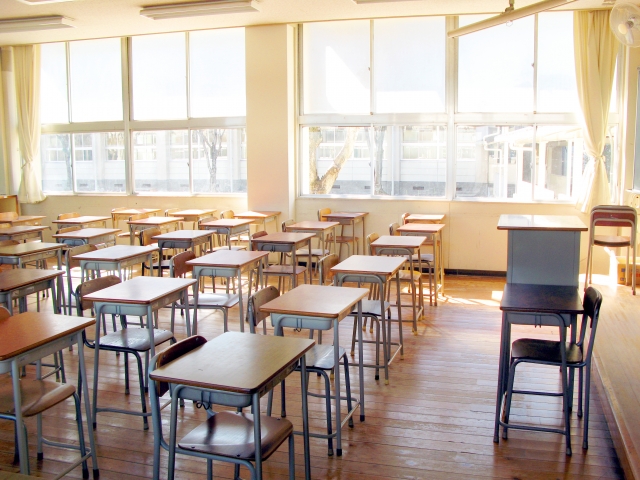Differences between Japanese classrooms and American classrooms
Education systems show characteristics of culture, value, and society of the country. Since Japan and America have different perspectives on those aspects, classrooms in those two are different. Today we will explain 13 differences between Japanese schools and American schools.
1. School Uniform
As often seen in anime and manga, Japanese students, often at middle schools and high schools, are required to wear school uniform or seifuku in Japanese. The traditional style of the uniform is sailor uniform for girls and gakuran uniform for boys. However, more and more schools have brazer uniforms for both male and female students, and some schools have minor types of uniforms, such as bolero, Eton jacket, and so on.
Shoes and bags are dependent on the school. Some schools require students to buy the designated bag and shoes, while other schools give students the freedom to choose what they want.
Most schools make strict rules on wearing uniforms. Common rules include bans on makeup, nail polish, and shortening skirts. Restrictions on hairstyles are also common. For example, bangs should not be longer than the eyebrow level, or hair should be cut shorter than 3 cm for boys.
School uniform functions not only as a symbol of schools but also as fashion, or known as nanchatte seifuku. School uniform is a common fashion item for kogal, often customized to look more fashionable by shortening skirts, changing ribbons, or wearing baggy socks.
2. Footwear

In almost all American schools, students do not need to change shoes when entering the school. However, in most Japanese schools, students have to change the footwear at the entrance. There are shoe boxes (getabako) for all the students at the entrance, and students change their shoes to school slippers (uwabaki).
3. One homeroom teacher per class
Generally, Japanese schools place students in one class before beginning a new school year, and students belong to the class for the whole academic year. One teacher is assigned to each class as a homeroom teacher, and he/she takes care of their homeroom class.
Homeroom teachers tell students important information about schools, consult each student about his/her future path (e.g., which high school/university he/she wants to go), and so on. In middle school, homeroom teachers visit their homeroom students’ house (katei-houmon) and talk with parents about how their students are doing at school. Katei-houmon is considered to play an important role for both parents and teachers in building relationships between them and knowing more about the students.
4. Morning meetings/ Afternoon Meetings
Before classes begin and after all the classes finish, meetings are held every day at homeroom classroom. The morning meeting begins with the greeting and goes on to taking attendance, checking the schedule of the day, making announcements if any, and lastly the teacher has a little talk. Some homerooms have a one-minute speech by the conductors (one or two students conduct the meeting).
The afternoon meeting begins with checking the schedule of the next day, and then has some announcements if any, teacher’s talk, and finishes with the greeting.
These meetings are highly valued in Japanese schools because the teacher can check the students’ health condition and keep them informed about news, changes or events of the school.
5. Teachers come, Students stay in the classroom
In American schools, it is normal for students to move to a different classroom from class to class. On the contrary, classrooms belong to students. Students spend most of their time in their homeroom classroom: homeroom classroom is like a “house” for students. In most Japanese schools, students stay in the same room except for some classes such as home economics, PE, music, art, and so on. Different teachers come to the classroom for every class, and after finishing class, they move to the different classroom.
Then, where do teachers make preparations for classes?
Almost all schools in Japan have “teachers room (shokuinshitsu),” where all the teachers have their desks and spend time on preparing for classes, having meetings, and so on.
6. All students have their textbooks
In elementary school and middle school, all the students have their own textbooks. Since elementary school and middle school are mandatory education, all textbooks are provided by the government for free. Students take textbooks home every day to do homework with them.
7. Greetings before/after the class
Greetings are considered very important in the Japanese society, and school is no exception. Before and after the class, student either stand up or remain seated and greet the teacher with a bow. This greeting not only shows respect and gratitude towards the teacher but also plays a role to make a clear borderline between the break time and the class, which helps students focus on the class.
8. How classes are conducted
Majority of the classes are conducted in the lecture-style. The teacher explains, and students listen with taking notes. The teacher sometimes asks questions or ask for volunteers, but most Japanese students are so shy that they rarely raise their hands. In that case, teachers do ”eeny, meeny, miny, moe.” Of course, it is not always the case; some students are willing to raise their hands and participate in the class.
Group discussions are not commonly seen in most Japanese schools. Students focus on their individual work, and they ask questions to the teacher if there are they don’t understand.
It seems contradictory considering that the Japanese society value teamwork and maintaining harmony in the community. However, the “team spirit” is nurtured apart from the class.
Normally, schools have excursions and field trips two or three times a year. Students make groups of four to six members, and they plan what they do on the small trip. Through organizing their activities on their own, they learn how to work together smoothly while keeping the harmony in the group. They also learn to assign roles to each member, and each individual feels responsible for doing their job.
9. Communication with teachers
As the Japanese society puts high importance on respecting someone older or someone in higher positions, students must follow teachers. They should speak to teachers in a respectful manner by using keigo, which is a way of talking with someone older or in higher positions than the speaker.
It is not considered to be good to say something against teachers, students tend to follow what teachers say. Moreover, during the class, students have to be silent and focus on the class not to mess the whole class; otherwise, the student who disturbed other students are labeled as “nasty student.” While this culture ensures the organized environment in class, students tend to become passive about expressing their opinions.
10. Lunch Time

While it is common in the US that students eat lunch at the cafeteria, almost all elementary schools and most middle schools have “school lunch.” A typical school lunch custom is that food is cooked at school and provided for each class, hot and fresh. Then, seven or eight students serve each dish for classmates and the homeroom teacher.
Students are assigned to “school lunch server” once in a month, with seven or eight students per week. Through serving lunch for peers, students learn the importance of equal distribution and a sense of hospitality and care for others.
When all the classmates have got their lunch, the teacher and students jointly say “Itadakimasu,” which shows gratitude for food, and start eating. During lunchtime, students make groups of four or five. It makes lunchtime fun and full of conversation, getting students bonded more strongly.
School lunch is not just lunch, but an essential educational element in Japanese schools. Majority of Japanese school lunch is comprised of three dishes with great nutritional balance and sometimes uses locally produced food. Students unconsciously learn the importance of well-balanced meal for staying healthy and what their local specialties are.
Moreover, if there is much food left in containers, the teacher asks students if there are any who want refills. This is based on “mottainai mindset,” which means feeling guilty for wasting food. It makes students try to finish their food till the last bite, and nurtures “mottainai mindset.”
11. Cleaning
Most Japanese schools do not have cleaning staffs, but they have time for cleaning. After lunch or just before the afternoon meeting, all the students clean the school. Each group of four or five students is assigned a particular place such as their homeroom classroom, stairs, halls, bathrooms, gym, etc. Each classroom is equipped with dustpans, brooms, and dust cloth and students use them for cleaning.
Through this cleaning time, students learn how to quickly and effectively clean the room by cooperating with classmates. Also, they acquire a sense of responsibility to take care of what they use.
Many tourists from around the world are astonished by the cleanliness of cities. It may come from the cleaning time from elementary school.
12. After school activities
Majority of middle-schoolers and high-schoolers belong to a club. Schools have tens of sports clubs and cultural clubs, and students spend afterschool time for club activities. Some clubs practice for tournaments or contests, other clubs make works for the cultural festival that usually takes place in autumn. Each club has teachers who take care of the club and coach the practice. Students usually have club activities both weekdays and weekends.
Club activities are one of the major components that comprise students’ school life, and that builds a strong responsibility to work for the team. Also, students learn to cooperate and strive for achieving goals by taking hand in hand with members and to think about how to solve problems in the team.
13. Ceremonies and school Events

Many ceremonies and school events take place throughout the year in Japanese schools. Starting from the entrance ceremony for new students and the new-year-ceremony for current students in April, sports festival, cultural festival, chorus contest, marathon, ballgame match, etc. are held, and the school year ends with “year-end ceremony” in March.
Every education system has pros and cons. While the Japanese education system does not seem good for some parts, it is working well for some parts as well. A sense of “team,” mottainai mindset, a value in politeness and cleanliness are nurtured through the current education system.
Did you find it interesting? Let us know in the comment down below!
